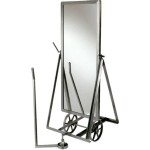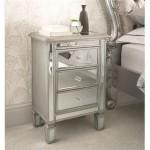How to Hang a Mirror Without Wire
Hanging a mirror securely and aesthetically pleasing on a wall doesn't always require wire. Several alternative methods provide stable hanging solutions for mirrors of varying sizes and weights. These methods leverage specialized hardware and mounting techniques, offering a clean, modern look while ensuring the mirror remains safely in place.
Utilizing French Cleats
French cleats offer a robust and discreet method for hanging heavier mirrors without wire. A French cleat consists of two interlocking pieces of wood or metal, one attached to the wall and the other to the back of the mirror. The angled design of the cleat creates a strong grip when the two pieces interlock, distributing the weight evenly. This method is particularly suitable for large, heavy mirrors where traditional wire hanging might not provide sufficient support.
To install a French cleat, begin by measuring and marking the desired location on the wall. Securely attach the wall portion of the cleat using appropriate screws and wall anchors, ensuring it is level. Next, attach the mating cleat to the back of the mirror, carefully aligning it with the wall cleat. Lower the mirror onto the wall cleat, ensuring the two pieces interlock firmly. The inherent strength of the French cleat system provides a secure and stable hanging solution.
Employing Mirror Adhesive
Mirror adhesive provides a straightforward method for hanging lighter mirrors, especially on smooth surfaces like tiles or painted walls. This specialized adhesive is designed to bond strongly with both the mirror and the wall material, offering a secure hold without the need for visible hardware. It's important to choose an adhesive specifically formulated for mirrors to prevent damage to the reflective backing.
Before applying the adhesive, thoroughly clean both the wall surface and the back of the mirror to ensure optimal adhesion. Follow the manufacturer's instructions for applying the adhesive, typically in vertical lines or a grid pattern. Carefully position the mirror against the wall, applying even pressure to ensure full contact with the adhesive. Use temporary supports, such as painter's tape, to hold the mirror in place while the adhesive cures completely, usually within 24 to 72 hours.
Mounting with D-Rings or Keyhole Hangers
D-rings and keyhole hangers provide another viable option for hanging mirrors without wire. D-rings are metal loops attached to the back of the mirror, which can be hung directly onto screws or hooks installed in the wall. Keyhole hangers, similar in concept, are slots cut into the back of the mirror that fit over screws or nails in the wall. These methods offer a clean, minimalist look and are suitable for mirrors of moderate weight.
When using D-rings, ensure they are positioned symmetrically on the back of the mirror and are securely attached. Measure the distance between the D-rings and mark corresponding locations on the wall. Install screws or hooks at these marked points, ensuring they protrude sufficiently from the wall to accommodate the D-rings. Carefully hang the mirror by placing the D-rings onto the screws or hooks.
For keyhole hangers, measure the distance between the top and bottom of the keyhole slots. Transfer these measurements to the wall and install screws at the marked points, leaving a small gap between the wall and the screw head to accommodate the keyhole slot. Carefully hang the mirror by sliding the keyhole slots over the screw heads.
Choosing the Right Method
Selecting the appropriate hanging method depends on several factors, including the weight and size of the mirror, the wall material, and the desired aesthetic. For heavier mirrors, French cleats or D-rings offer superior support. Lighter mirrors can be securely hung using mirror adhesive or keyhole hangers. Consider the wall material as well; some methods are more suitable for certain wall types than others. For instance, adhesive may not be ideal for textured or uneven walls.
Before hanging any mirror, carefully assess the specific requirements of the project and choose the method that best suits the situation. Always prioritize safety and stability to ensure the mirror remains securely in place.
Preparing the Wall and Mirror
Proper preparation is crucial for any mirror hanging project. Begin by carefully cleaning the wall surface where the mirror will be hung. Remove any dust, dirt, or debris that might interfere with adhesion or create an uneven surface. If necessary, repair any imperfections in the wall, such as cracks or holes, before proceeding.
Similarly, clean the back of the mirror to ensure it is free of dust and debris. This is particularly important when using adhesive, as a clean surface ensures optimal bonding. Protect the mirror's surface during installation by using soft cloths or padding to prevent scratches or damage.
Safety Considerations
Safety should always be a primary concern when hanging mirrors, especially heavier ones. When working with power tools, wear appropriate safety glasses and follow all manufacturer's instructions. When lifting heavy mirrors, use proper lifting techniques to avoid injury. Enlist assistance if needed, especially for larger or heavier mirrors. Ensure the chosen hanging method is appropriate for the weight of the mirror and the wall material. After hanging the mirror, periodically check the mounting hardware to ensure it remains secure and stable.
How To Hang A 100 Pound Mirror On Drywall Quora

How To Hang A Hanging Mirror Without Accompanying Hardware

How To Adjust A Mirror Art Or Picture Hanging Wire

3 Simple Ways To Hang A Mirror On Wall Without Nails Wikihow

3 Simple Ways To Hang A Mirror On Wall Without Nails Wikihow

How To Hang A Heavy Mirror Taskrabbit Blog

How To Hang A Heavy Mirror Securely Bob Vila

Picture Wire Strung Between Two D Rings Attached To The Back Of A Frame Hanging Mirror Heavy

How To Hang A Heavy Mirror On Brick Wall Hanging Tips Easy Tutorial Homify

How To Hang A Mirror Home








